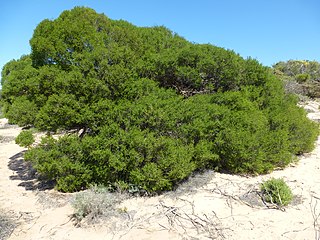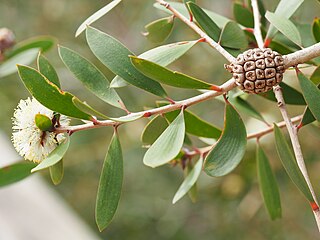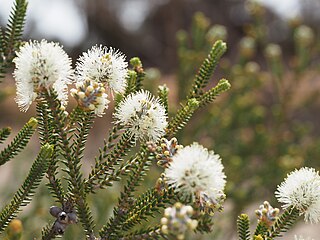Melaleuca penicula is a plant in the myrtle family, Myrtaceae and is endemic to the south of Western Australia. It is a rare species only known from the Fitzgerald River National Park and resembles Melaleuca eximia with its spikes of red flowers but its leaves and stamen bundles are different.
Melaleuca boeophylla is a plant in the myrtle family, Myrtaceae and is endemic to the south-west of Western Australia. It is similar to a number of other Western Australian melaleucas such as M. filifolia with its purple pom-pom flower heads but its leaves are shorter and oval in cross-section.
Melaleuca eximia is a plant in the myrtle family, Myrtaceae and is endemic to the south of Western Australia. It is distinguished by its leaf arrangement, its large, showy red inflorescences and the large, furry bracts under the flowers.

Melaleuca phoidophylla is a plant in the myrtle family, Myrtaceae and is endemic to the south-west of Western Australia. It is distinguished by its leaf arrangement, small raised blisters on the leaves and heads of white or cream flowers on the ends of the branches in spring.
Melaleuca similis is a plant in the myrtle family, Myrtaceae and is endemic to the south west of Western Australia. It is a small shrub, similar to Melaleuca stramentosa with its narrow, almost cylindrical leaves and heads of pink to purple flowers but lacks the matted, silky hairs on the young leaves and outer edge of the flower cup.

Melaleuca brevifolia, commonly known as mallee honey-myrtle, short-leaf honey-myrtle, or d'Alton's melaleuca is a shrub or tree in the myrtle family, Myrtaceae, and is native to western Victoria, south-eastern South Australia and the south-west of Western Australia. It is a shrub with rough, corky bark and a large number of heads of white to yellowish flowers on the previous season's growth. It is a moderately hardy garden plant.

Melaleuca araucarioides is a plant in the myrtle family, Myrtaceae and is endemic to a small area of the south-west Western Australia. It is a many-branched shrub with the leaves arranged in a way that gives the plant the appearance of a conifer.

Melaleuca urceolaris is a low, spreading shrub in the myrtle family Myrtaceae and is endemic to the south-west of Western Australia. Although it is rare in cultivation, it is an attractive garden plant due to its soft foliage and white flowers which fade to pink or red. It is similar to Melaleuca scabra with which it has often been confused.

Melaleuca cardiophylla, commonly known as tangling melaleuca or umbrella bush is a plant in the myrtle family, Myrtaceae and is endemic to the west and south-west of Western Australia. It is a dense, prickly shrub with heart-shaped leaves, stamens that are joined in unusually long claw-like bundles, and distinctive, warty fruits.

Melaleuca globifera is a shrub in the myrtle family, Myrtaceae and is endemic to the south-west of Western Australia. It is a bushy, small tree with papery bark and spherical heads of flowers on the ends of the branches.
Melaleuca nanophylla, commonly known as dwarf-leaved honey-myrtle is a rare plant in the myrtle family, Myrtaceae and is endemic to two small areas, one in Western Australia and the other in South Australia. It has tiny leaves with their upper surfaces pressed against the stems and small heads of white or pale yellow flowers.

Melaleuca pauciflora is a shrub in the myrtle family Myrtaceae, endemic to the south-west of Western Australia. Its decussate leaf arrangement and its small heads of white flowers on the sides of its branches are diagnostic. This is probably the least spectacular of all the melaleucas.

Melaleuca pomphostoma is a plant in the myrtle family, Myrtaceae, and is endemic to the south-west of Western Australia. It is a small, dense shrub with fleshy, narrow leaves, greenish-yellow flowers. It is similar and closely related to Melaleuca bracteosa but differs in the colour and number of stamens in each flower.

Melaleuca quadrifaria, commonly known as limestone honey-myrtle, is a plant in the myrtle family, Myrtaceae, and is native to the south of Western Australia. It is distinguished by the small size and arrangement of its leaves combined with its small spikes of white or cream flowers.
Melaleuca sciotostyla, commonly known as Wongan melaleuca, is a plant in the myrtle family, Myrtaceae, and is endemic to the south-west of Western Australia. It is an endangered species with only 476 mature plants known in 2001. It is closely related and very similar to Melaleuca haplantha but has narrower leaves and fewer stamens per flower than that species.

Melaleuca sclerophylla is a plant in the myrtle family, Myrtaceae, and is endemic to the south-west of Western Australia. It is distinguished by its unusual leaves which are rough, leathery and covered with small, warty lumps and by its many purple heads of flowers in early spring.
Melaleuca sculponeata is a plant in the myrtle family, Myrtaceae, and is endemic to the south-west of Western Australia. It is a small, rare shrub with fleshy leaves and white heads of flowers.

Melaleuca seriata is a shrub in the myrtle family, Myrtaceae, and is endemic to the south-west of Western Australia. In describing it, John Lindley wrote "Melaleuca seriata, parviceps, and trichophylla, are bushes, every twig of which is terminated by hemispherical heads of a brilliant pink." It is very similar to Melaleuca parviceps.
Melaleuca sophisma is a plant in the myrtle family, Myrtaceae, and is endemic to the south-west of Western Australia. It is superficially similar to Melaleuca cliffortioides but differs from it in the arrangement of the flowers and in details of the leaves. The flowers are white, fading to cream and are arranged in small heads on the sides of the branches.
Melaleuca subalaris is a plant in the myrtle family, Myrtaceae, and is endemic to the south of Western Australia. It is distinguished by its small, decussate leaves and small flower heads which rarely have more than one flower in each inflorescence.














